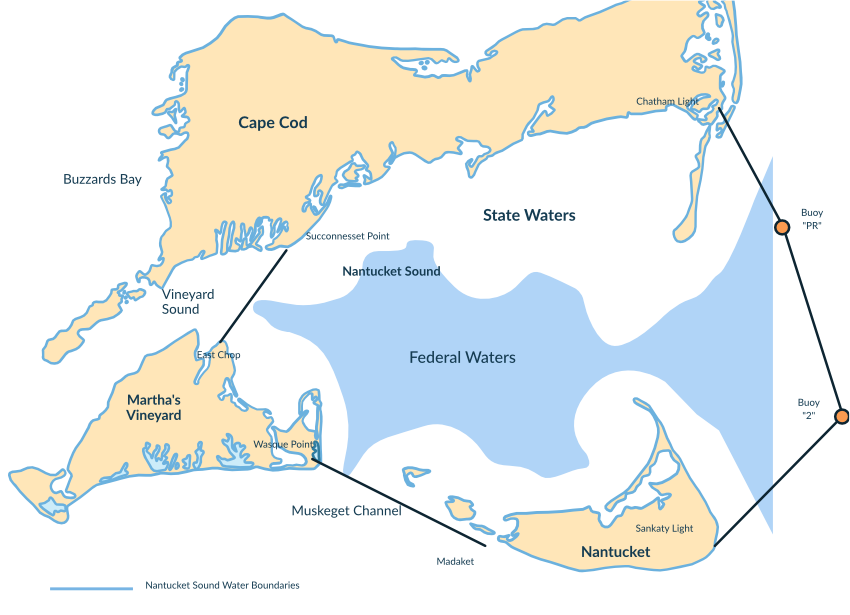The Heart and Soul
of the Cape and Islands
Nantucket Sound is the body of water between Cape Cod and the islands of Martha’s Vineyard and Nantucket. It is situated at a confluence of the cold Labrador Currents and the warm Gulf Stream. This convergence creates a unique coastal habitat, representing the southern range for Northern Atlantic species and the northern range for Mid-Atlantic species. Nantucket Sound is characterized by remarkable richness of biological diversity, with habitats ranging from open sea to tidal flats, salt marshes, and estuaries. The complex networks of habitat utilization and species competition within the Sound remain an area for significant scientific research.
Nantucket Sound and the waters surrounding the Cape and Islands are famous for their natural beauty and abundant, diverse, and unique wildlife. The Sound is also renowned for recreational boating and fishing, and contributes to drawing over six million visitors annually to Cape Cod and the islands of Nantucket and Martha’s Vineyard. It is a source of livelihood for fishermen, and a source of solace, relaxation, and recreation for millions of visitors. Nantucket Sound is essential to our regional economy precisely because of its natural appeal.
“The ocean and bays that surround us are perhaps our town’s most important and defining natural resource and it is these unspoiled waters that are the very essence of Cape Cod.”
Barnstable Land Trust

State vs. Federal Jurisdiction
The waters of Nantucket Sound that go from the shoreline of Cape Cod and the Islands out to three miles belong to the Commonwealth of Massachusetts. The center of the Sound, however, is under federal jurisdiction. Nantucket Sound’s jurisdictional boundaries delineated by the U.S. Supreme Court resulted in this section of federally owned waters surrounded by state waters. In United States v. Maine (1975), states have jurisdiction over all submerged lands within the three-geographical mile zone, and the U.S. has title to the seabed more than three miles from shore.
This jurisdictional delineation, however, does not apply to bodies of water such as Cape Cod Bay. Because the Bay has only one outlet to a single larger body of water and a borderline can be drawn between two points on either side of the opening, the body of water is “contained,” and the three-mile ruling does not apply.
A Sound, on the other hand, is a coastal waterway that has two or more outlets and cannot be contained by a single borderline, therefore, state waters end at the three-mile boundary.
Traditional Cultural Property
In 2010, the National Park Service determined that Nantucket Sound is eligible for listing in the National Register of Historic Places as an historic and archaeological property and as a traditional cultural property (TCP). Nantucket Sound was once exposed land where the Wampanoag people traversed, fished, cultivated, interred their ancestors, and occupied. As such, the Sound has yielded, and has the potential to yield, important information about the Native American exploration and settlement of the Cape and Islands.
The National Park Service further acknowledged that both the Aquinnah Wampanoag Tribe on Martha’s Vineyard and the Mashpee Wampanoag Tribe on Cape Cod attach religious and cultural significance to Nantucket Sound and to the larger historic district that encompasses the near shore areas of the Sound. Thus, the entirety of the waters and seabed of Nantucket Sound is a TCP.
Nantucket Sound is eligible as an integral, contributing feature of a larger district, whose boundaries have not been precisely defined, under:
- Criterion A for its associations with the ancient and historic period Native American exploration and settlement of Cape Cod and the Islands, and with the central events of the Wampanoags’ stories of Maushop and Squant/Squannit;
- Criterion B for its association with Maushop and Squint/Squannit;
- Criterion C as a significant and distinguishable entity integral to Wampanoags’ folklife traditions, practices, cosmology, religions, material culture, foodways, mentoring, and narratives; and
- Criterion D for the important cultural, historical, and scientific information it has yielded and/or may be likely to yield through archeology, history, and ethnography about access to resources, patterns of settlement, mobility, and land use prior to and after 6,000 years ago as a result of the inundation of the Sound. It is also important for the significant information it provides and can provide about the cultural practices and traditions of the Native Americans of Cape Cod and the Islands in relationship with other peoples since ancient times.

